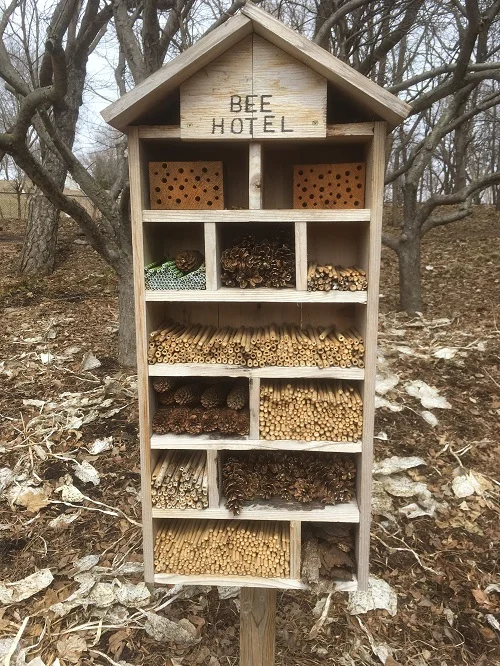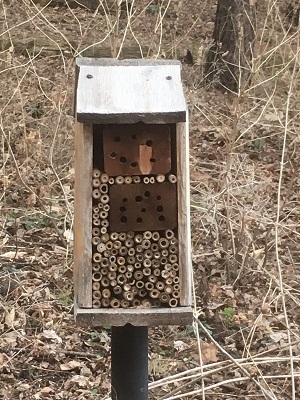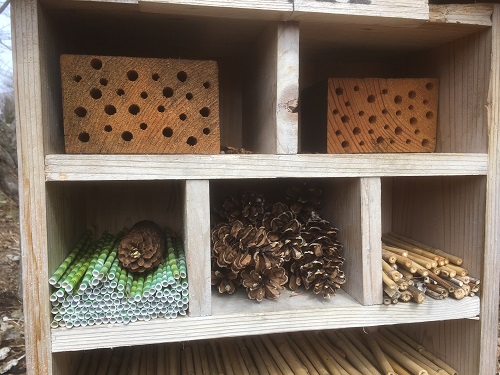Bee Hotels
Native Bees are losing their natural habitat. Creating a Bee House will help these cavity nesting pollinators survive and proliferate.
Growing pollinator friendly plants is very helpful but those pollinators also need a place to live. Planning limited specific cleanup of our gardens in fall can help provide habitat for some of our bees and pollinators. More than ever, with the decline of honeybees in managed hives, it is important to protect our most effective pollinators, the natural wild bee pollinators. About 70 to 80 percent or our native bees nest in the ground and our affinity for neat and cleaned up lawn and gardens has seriously limited available habitat for ground nesting bees. Changing the way we clean out our gardens make a big difference and most gardeners are making those changes.
But we also need to increase nesting places for our cavity nesting bees. About 15 percent of our native bees nest in tiny tunnels, tubes and holes. They look for hollow plant stems, cracks and holes in wood, crevices and spaces between rocks, beetle tunnels in tree trunks, any crevice that is just right for their single nest. These nesting bees are solitary bees, building single nests just for themselves, but they often aggregate their nests where good nesting sites exist. A “commune” of nests may even have a single entrance.
Creating a bee hotel will help these non-aggressive pollinating bees. You cannot, however, put up a bee house and expect that you are done. The habitat must be managed long term or you could wind up killing bees instead of nurturing them. And a variety of bees will use the habitat, all of different sizes., shapes, colors and appearance. Some don’t even look much like a bee. But all are docile and non-aggressive unless threatened directly, including mason bees, carpenter bees, yellow faced bees, leaf cutter bees and sweat bees.
Build a Bee House
Get creative using simple materials for your bee habitat. It doesn’t necessarily have to be pretty, just functional. Keep in mind that different sized bees will need different sized cavities so a variety of housing material should be used. Of course you can purchase a pollinator house and just install it if you are not too handy or material availability is an issue. However many of the ready made houses are not sufficiently protected from the weather.
The framework to hold nesting cavities should be about 6 to 8 inches deep and firmly mounted to a post, tree, fence, etc.
Use stacked cinder blocks, birdhouse frames, or sturdy jars for the framework of a homemade bee hotel. The back should be closed off and a protective rain shedding roof with a deep front overhand should be added.
A complete house can be made by simply drilling holes into a large piece of tree trunk or untreated wood block. Drill holes of varying diameters and depths to appeal to different size bees. Holes can range from 1/8” to 1/2” in diameter and 3” to 6” deep.
Locate the house in morning sun if possible. Ideally it should be south facing so it is warm in spring and fall.
For a small house, insert a block of wood with cavities pre-drilled, or fill with hollow stems of various sizes pre-cut to the depth of the house. Use pieces of small bamboo or reeds, dried hollow plant stems like Joe Pye Weed, Peony, Hydrangea, cardboard tubes or plastic straws. For a larger house you can frame in “rooms” and use a combination of wood blocks, hollow stems and large cardboard or pvc tubes filled with more stems. Bees will also make good use of the crevices in pine cones and stacked strips of tree bark.
Chicken wire over the front will help deter the birds from harvesting larvae but will not bother the bees.
Bee House Care and Management
Taking good care of the bee hotel is critical to prevent larvae death from mold, fungus and parasite pests.
At the end of each summer observe every cavity. If it is still closed up with mud, no young bee has emerged. Remove the entire cavity cell to destroy the contents including whatever caused the larvae death.
There is a tiny fly that creates a small hole in the end mud plug. Its’ larvae eats the pollen stored for the bee larvae as well as the bee larvae. In late summer careful inspect for the entry holes to destroy any cells they occupy before the adult flies can emerge in spring. These pests have been a huge factor in the population reduction of solitary bees.
Deteriorated plant stems and cardboard should be replaced at the end of every summer.
Every two years replace all wood blocks and tree trunk cuttings. They will have begun to harbor mold, mites, fungus and parasites. Prepare the replacements ahead of time and be sure all new young bees have left the cavities. If you have leaf cutter bees they generally emerge quite late. In this case removed the occupied blocks and place them under something protective with an opening on the ground until they have emerged. A sturdy box or an old bucket with a cutout works well.
Keep the house dry over winter. Cold is not a problem but wind blow rain in winter will dissolve the mud plugs closing the cavities, as well as encourage rot and fungus. If your bee house is too exposed, store it in a COLD but dry location over winter. An attached garage is too warm and the larvae will not remain dormant as is necessary.
Note that bees will prefer natural materials, untreated woods, and will avoid painted or stained materials until the smell is completely gone, often weeks. Cardboard materials may have to be replaced every year if they are retaining moisture and deteriorating. Any plastic materials must be thoroughly cleaned every spring after the young bees have emerged. You might find it easy to create “disposable” habitats by placing prepared wood blocks or bundled stems in a tree crotch. Or make two habitats to rotate. In spring the overwintered house can be allowed plenty of time to empty and the second house can be mounted for spring nesting.



